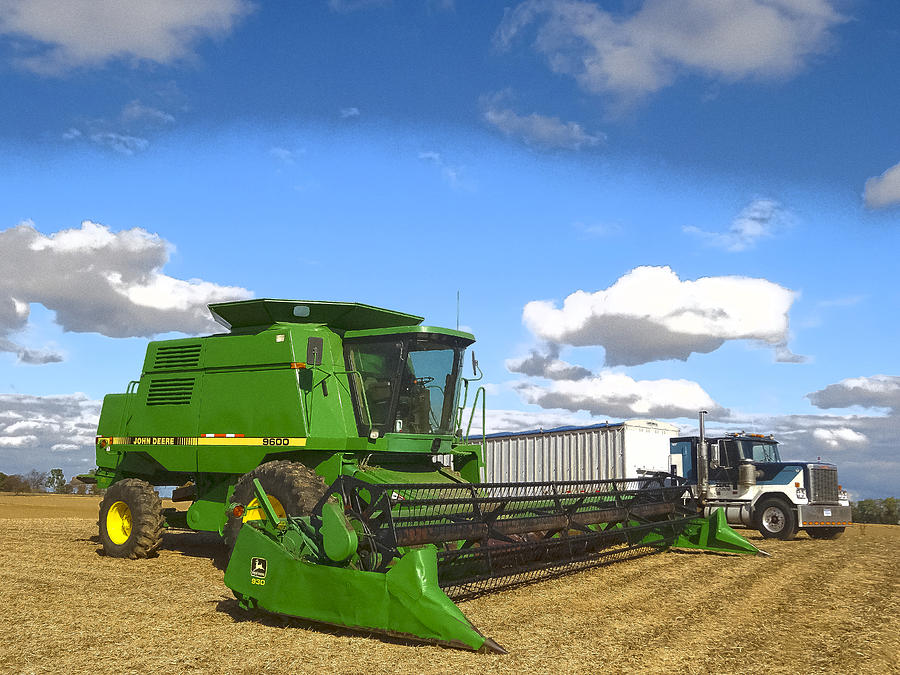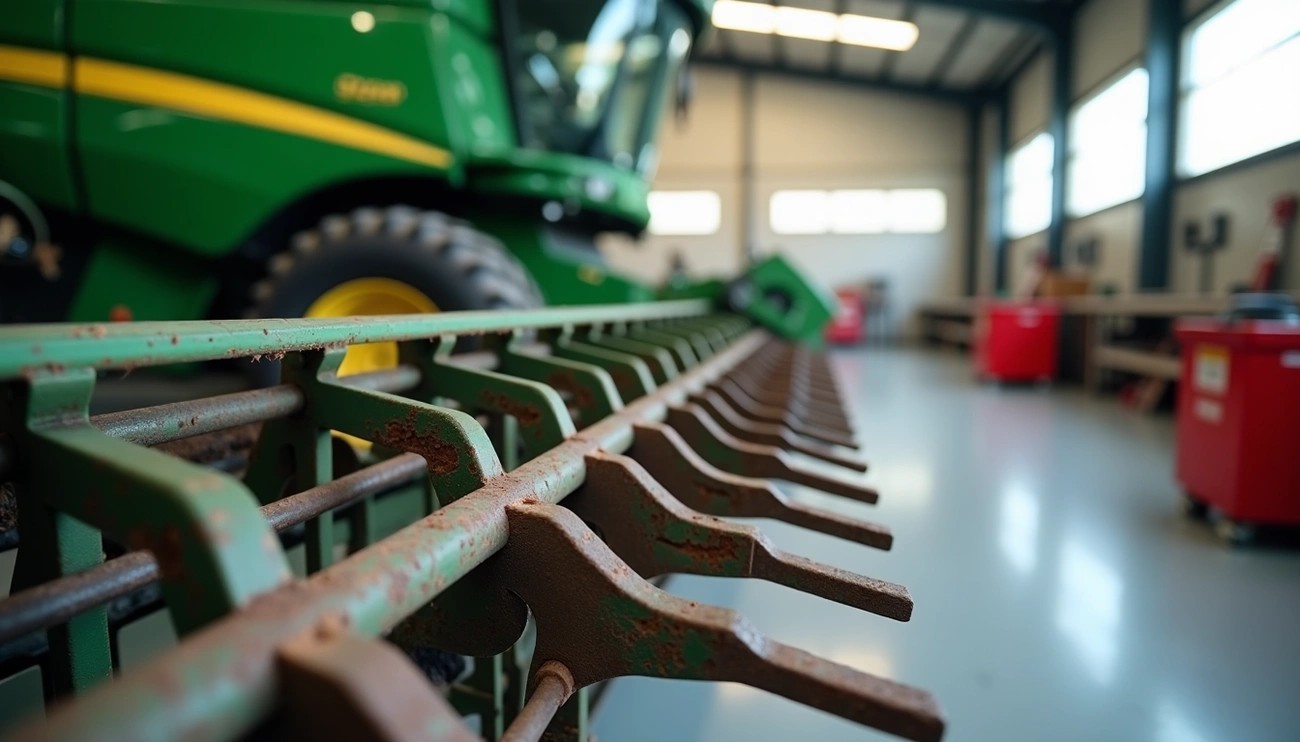Did you know that a single loose bearing in your combine concaves could lead not just to damaged parts but potentially start a fire?
Each year, technicians service between 30 to 40 combines annually, and many of these repairs could have been prevented with proper pre-season maintenance. The concave is actually “the cornerstone of threshing” and “the heart of the machine”, making it one of the most critical components to monitor. When functioning properly, combine concaves ensure efficient grain separation from stalks, however, when they begin to fail, the consequences extend far beyond poor performance.
Getting your combine set up correctly can make a tremendous difference to harvest grain losses and ultimately affect your crop profitability. Furthermore, changing your concaves when needed can create a massive difference in your machine’s capacity and performance. In this article, we’ll walk through the telltale signs that your combine concaves need replacement, from visible wear indicators to performance issues that signal it’s time for an upgrade.
Visible Signs of Wear on Combine Concaves
Proper inspection of combine concaves should be a yearly ritual, ideally long before harvest season begins. To thoroughly assess your concaves, you must remove them from the machine and examine them carefully.
Cracks, bends, or missing wires
The first telltale signs of worn concaves are structural issues. During routine maintenance, I recommend checking for cracked designs, deformities, or damaged components. If concaves have cracks in support structures, they need immediate attention. Cracks often appear at stress points—particularly at 90-degree bends or in gusset areas. Missing or broken wires are equally concerning; once several wires are damaged, replacement becomes more cost-effective than repair.
Some operators discover that cross bars in concaves break when foreign material passes through the machine. Additionally, many machines show bent or missing wires, especially after several seasons of use. These structural defects significantly reduce threshing performance and can lead to more serious mechanical issues if left unaddressed.
Rounded bars or worn edges
As concave bars wear down, their edges become dull and rounded, decreasing the friction needed for proper threshing. This reduced friction allows crop to slide through too quickly, preventing proper grain separation. Place a straight edge along the bars—if there’s a gap exceeding 1/8″ in the middle, it’s time for replacement.
I’ve found that center wear is especially common, with some operators reporting their concaves worn down approximately 1/8″ in the center compared to the edges. This uneven wear creates a bow-like shape that prevents consistent threshing across the entire width. Even a seemingly minor 2mm bow can dramatically impact performance, especially with small grains.
Rust or corrosion on concave surfaces
Rust and corrosion are silent destroyers of concave efficiency. During pre-season inspections, examine all metal surfaces for signs of oxidation. If you notice rust formation, particularly on bearing surfaces, replacement may be necessary since rusted bearings can cause significant operational problems.
For minor surface rust, consider patching with paint to prevent further deterioration. Nevertheless, extensive corrosion compromises structural integrity and threshing capability, ultimately requiring replacement rather than repair.
Inspecting your combine concaves after approximately 400 hours for swath pickup operations or 600-700 hours for straight cutting is advisable. This proactive approach prevents unexpected failures during the critical harvest window.
Performance Issues During Harvest
While visual inspection reveals obvious damage, performance issues during operation often provide the first indication that combine concaves need replacement. Looking beyond what you can see with your eyes, let’s examine how concave wear affects your harvest results.
Increased grain loss or poor separation
Even with proper settings, worn concaves lead to substantial yield losses. In one study, farmers lost approximately 1 bushel of corn per acre during harvest. This occurs because damaged concaves cannot maintain proper threshing pressure, causing grain to exit with the chaff instead of entering the grain tank.
Watch for these signs of separation problems:
- Excessive grain visible behind the combine
- Uneven loads across the sieves causing poor cleaning
- Need for drastically different settings than previous seasons
Separation issues worsen as concave wear progresses, ultimately resulting in decreased yield. Although adjusting settings might temporarily improve performance, it cannot compensate for severely worn components.
Cracked or damaged grain in the tank

Cracked grain in your tank directly points to concave problems. Damaged kernels not only reduce market value but also indicate inefficient threshing. Studies show increasing cylinder speed from 300 to 600 rpm can raise kernel damage from below 5% to over 30%.
Cylinder/rotor speed remains the leading cause of grain damage, yet operators often increase speed attempting to compensate for worn concaves. This creates a damaging cycle where concave wear leads to higher speeds, consequently resulting in more cracked grain.
Reduced threshing efficiency
Poor threshing efficiency manifests through incomplete grain separation or excessive power requirements. Concaves represent “the cornerstone of the threshing operation”, so their degradation affects overall harvest performance.
Worn concaves often necessitate tighter clearances or faster rotor speeds, placing additional strain on your combine. Accordingly, if you notice your machine suddenly requires different settings to achieve the same threshing results as previous seasons, inspect your concaves immediately.
The goal of proper combine settings is achieving smooth, even crop flow. Once concaves wear beyond certain limits, no amount of adjustment can restore optimal performance, making replacement the only viable solution.
Mechanical Indicators That Signal Replacement
Beyond visible wear and performance issues, your combine concaves often send mechanical signals indicating replacement is needed. These signs typically emerge when structural integrity is compromised.
Unusual noises or vibrations
Listen carefully for metal-on-metal sounds coming from the rotor or feederhouse area. These distinctive clanking noises often occur when pushing the combine at higher speeds through heavy crop volumes. Moreover, you might feel vibrations through your feet while operating. These vibrations aren’t just annoying—they indicate potential structural issues that can lead to catastrophic failures.
Excessive rotor power requirements
When concaves wear or become damaged, your combine must work harder to achieve proper threshing. You’ll notice this as the machine struggling to maintain speed even in normal crop conditions. Indeed, concaves that are too open can cause material to start “round baling” inside the machine, creating serious power drains and potentially damaging other components.
Concave misalignment or loose fittings
Precision is essential with concave positioning. Ideally, concaves should be level within 3/32″ at the front. Subsequently, if you notice uneven threshing or inconsistent crop flow, check for misalignment. Many operators discover twisted adjustment rods—a common issue with wide-body machines. Properly aligned concaves and rotors are crucial for efficient operation.
Difficulty adjusting concave settings
When concave adjustment mechanisms fail to respond properly, replacement is often necessary. Watch for situations where the display shows concaves at “0” (fully closed) yet they don’t physically bottom out against the stops. Likewise, if settings shown on the monitor don’t match what you observe visually, the adjustment system may be failing.
When to Replace vs. Repair Combine Concaves
Making the decision between repairing and replacing combine concaves requires careful consideration of multiple factors. Let me walk you through this crucial evaluation process.
Evaluating cost-effectiveness of repair
The financial aspect often drives the repair-or-replace decision. For minor damage, straightening bars and threading new wires might be sufficient. Yet for severely bent or worn units, replacement becomes more economical. Drum rebuilds typically cost between £395 and £695, while basic concave refurbishments start around £550. Comparatively, new heavy-duty Hardox concaves range from £1,400 to £2,200. Consider these figures against your harvesting schedule—repairs taking “immense time” during harvest season can cost more in lost productivity.
Impact on long-term machine performance
Properly maintained concaves extend the lifespan of your entire combine. Regular systematic maintenance dramatically reduces breakdown frequency. Conversely, continuing to use worn concaves forces you to increase cylinder or rotor speed to compensate, creating a cascade of issues throughout your machine. The durability aspect cannot be overstated—quality aftermarket concaves can harvest approximately 5,000 bushels per hour while increasing ground speed by roughly 3 miles per hour.
How to choose the right replacement concave
Initially, determine whether you need crop-specific or multi-crop concaves. Modern replacement options can handle diverse crops including corn, soybeans, wheat, canola, and sunflower without swapping hardware. Essentially, this eliminates downtime between crop transitions. Check compatibility with your combine model, as aftermarket concaves work with various manufacturers. Finally, research thoroughly—consult fellow farmers through personal contacts and online farming communities to ensure you’re selecting quality components.
Conclusion
Maintaining your combine concaves represents one of the most crucial aspects of harvest equipment management. Throughout this article, we’ve seen how damaged concaves can severely impact your operation through visible wear, performance decline, and mechanical issues.
Regular inspection remains your best defense against unexpected breakdowns during critical harvest windows. Therefore, I recommend establishing a consistent maintenance schedule that includes thorough concave examination before each season begins. This proactive approach helps prevent costly downtime when you need your equipment most.
The financial implications of neglected concaves extend far beyond repair costs. Undoubtedly, reduced threshing efficiency translates directly to lost yield and decreased profits. Many farmers overlook small issues until they escalate into major problems requiring complete replacement rather than simple repairs.
Your decision to repair or replace should balance immediate costs against long-term performance benefits. Aftermarket options now provide impressive versatility across multiple crop types, essentially eliminating the need for frequent concave changes between different harvests.
Remember that proper concave function affects your entire combine’s performance. Worn components force compensatory adjustments that strain other parts of your machine. Consequently, what might seem like a small issue can quickly cascade into system-wide inefficiencies.
The bottom line remains clear – your combine’s concaves deserve careful attention. They function as the heart of your threshing system, and their condition directly affects your harvest results. Take time now to inspect your equipment thoroughly, address any concerns promptly, and you’ll reap the rewards of improved efficiency and yield during harvest season.

